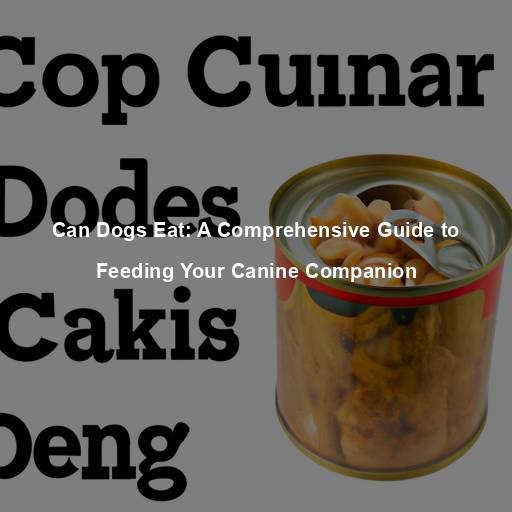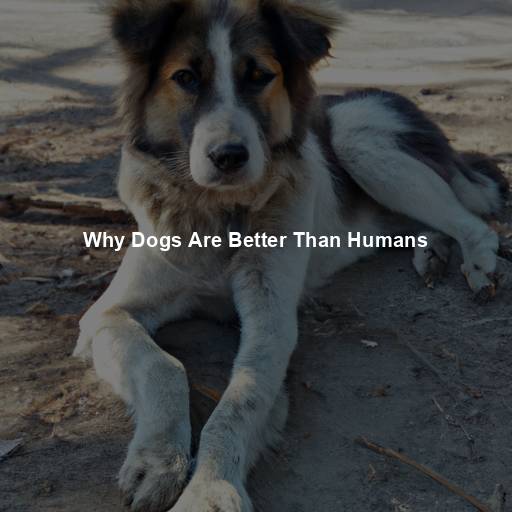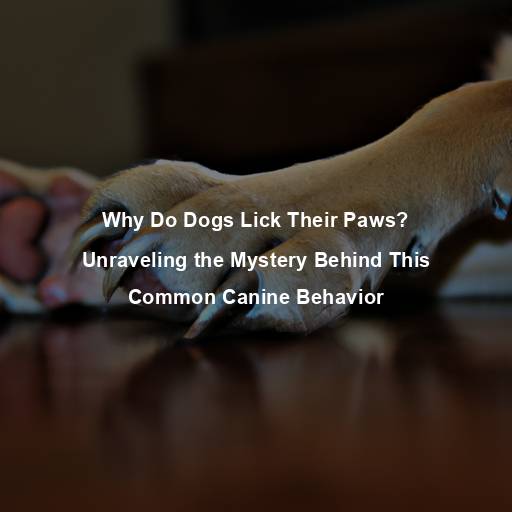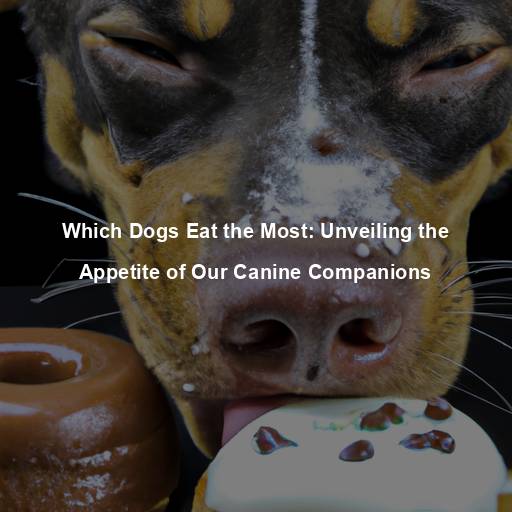Can Dogs Eat: A Comprehensive Guide to Feeding Your Canine Companion
Last Updated on August 8, 2023 by Evan
Contents [hide]
- 1 Understanding Canine Nutrition: Unraveling the Can Dogs Eat Conundrum
- 2 Can Dogs Eat: Debunking Common Myths and Misconceptions
- 3 Foods Dogs Can Safely Enjoy: A Doggie Delicacy Delight
- 4 Consult Your Veterinarian: The Importance of Professional Guidance
- 5 Food Allergies and Sensitivities: Navigating Dietary Restrictions
- 6 The Importance of Water: Hydration for a Healthy Hound
- 7 FAQs: Can dogs eat?
Understanding Canine Nutrition: Unraveling the Can Dogs Eat Conundrum
Dogs have long been regarded as man’s best friend, offering unwavering loyalty, companionship, and endless love. As responsible pet owners, it is our duty to ensure their well-being, which includes providing them with a nutritious and balanced diet. However, the question of what dogs can and cannot eat can often leave pet owners perplexed. In this comprehensive guide, we will delve into the world of canine nutrition, shedding light on what foods are safe, potentially harmful, and downright dangerous for our furry friends.
The Basics of Canine Nutrition: A Balanced Diet for Fido
Just as we humans strive for a harmonious life, our furry companions, too, depend on a carefully curated menu for their overall well-being. Picture a dog’s plate as a complex puzzle, where proteins, the building blocks of life, fortify young muscles and mend worn-out tissues. Meanwhile, the humble carbohydrates step up to the plate, providing the boundless fuel needed to wag those tails and chase squirrels. Oh, and let’s not forget the fats, the unsung heroes responsible for those luscious, glossy coats and velvety soft skin.
It is important to note that while dogs share many similarities with humans in terms of nutritional requirements, there are certain foods that can be harmful or toxic to our four-legged companions. Let’s explore some common foods and whether they are safe for our furry friends.
Can Dogs Eat: Debunking Common Myths and Misconceptions
Chocolate: A Sweet Treat or a Potential Hazard?
There’s a common misconception floating in the air, swirling around like cocoa dust. Delicious to us, but perilous for our furry friends. Ah, chocolate, a treat we humans adore, but alas, a treat that spells trouble for our canine companions. Hidden within its luscious facade lies a perilous substance called theobromine, a compound that dogs struggle to break down as swiftly as we do.
Grapes and Raisins: Innocent Fruits or Hidden Dangers?
When it comes to our four-legged companions, we often underestimate the potential dangers lurking in our own kitchen cabinets. Take grapes and raisins, for example – innocent-looking treats that could send our furry friends tumbling down a perilous path. Surprisingly, even a handful of these seemingly harmless morsels can trigger a cascade of catastrophic events within a dog’s delicate system. The repercussions may range from an upset stomach to a full-blown kidney failure, leaving our beloved pets grappling with torrential symptoms like vomiting, diarrhea, and a disturbingly diminished appetite.
Onions and Garlic: Flavor Enhancers or Potential Toxins?
Have you ever stopped to wonder about the ingredients we use in our daily meals? It turns out that some seemingly harmless staples like onions and garlic can actually pose a serious threat to our four-legged companions. These innocent-looking ingredients contain compounds that have the potential to harm a dog’s red blood cells, leading to a perplexing condition known as hemolytic anemia. If you notice your furry friend feeling weak, lethargic, or sporting pale gums, it might be a result of consuming raw or cooked onions and garlic.
Foods Dogs Can Safely Enjoy: A Doggie Delicacy Delight
Discover a world of culinary delights for your beloved furry friend as we unveil a tantalizing array of canine-friendly foods. While it’s important to exercise caution when considering what to feed your dog, there are a plethora of delectable and nourishing alternatives that can be seamlessly integrated into their diet. Join us as we embark on a journey of wholesome and mouthwatering options that will leave Fido begging for more.
Lean Meats: A Protein-Packed Powerhouse
Lean meats, such as chicken, turkey, and beef, are excellent sources of high-quality protein for dogs. When preparing meat for your four-legged friend, ensure it is boneless, skinless, and cooked thoroughly to avoid any potential bacterial contamination. It is also important to remove excess fat, as a high-fat diet can lead to weight gain and other health issues.
Fruits and Vegetables: Nature’s Bounty
It’s no secret that our furry friends can benefit from a little extra nutrition boost, and what better way to do that than with a selection of fruits and veggies? But here’s the twist: not all of them are dog-approved. So before you start dishing out the goods, let’s take a moment to navigate the world of pet-friendly produce. Think apples (minus the pesky seeds), blueberries that pack a punch, crunchy carrots, and good ol’ green beans.
Peanut Butter: A Canine Favorite
Peanut butter is a popular treat among dogs, and fortunately, it can be a healthy addition to their diet when given in moderation. Opt for natural peanut butter without added sugars or artificial sweeteners, as these can be harmful to dogs. Peanut butter is not only a great source of protein but also a tasty way to provide healthy fats and vitamins.
Consult Your Veterinarian: The Importance of Professional Guidance
As you peruse this comprehensive guide on canine cuisine, immerse yourself in the wealth of knowledge encompassing the delicate balance between nutritional bliss and potential peril for your beloved four-legged friend. Embrace the enigma that is your dog’s palate, intricately woven with individual intricacies influenced by a multitude of factors: breed, age, weight, and the enigmatic tapestry of underlying health conditions. Yet, in this bewildering culinary landscape, one beacon of clarity remains: consult the sagacity of a veterinarian before embarking on any audacious crusade to revolutionize your pup’s gastronomic experience.
When it comes to your furry friend’s nutrition, who better to turn to than your reliable veterinarian? With their expertise and deep understanding of your dog’s unique requirements, they can expertly craft a personalized meal plan, taking into account factors like age, breed, and activity level. This tailored approach guarantees that your beloved companion receives a wholesome and balanced diet, brimming with all the essential nutrients they need to flourish.
Understanding Dog Food Labels: Decoding the Ingredients
When it comes to selecting the ideal commercial dog food, the perplexing task lies in unraveling the enigmatic ingredients meticulously printed on the label. Plunge into the bewildering world of dog food aplomb, ameliorating in the quest for optimum nutrition. Within this labyrinth, seek the holy grail of high-quality protein sources – the likes of regal chicken or noble beef – bestowed the honor of being crowned the main ingredient. In your ascent, be wary of treacherous pitfalls, avoiding the snares of fillers, by-products, and the insidious presence of artificial additives, whose ominous shadows may cast a pall over your precious canine companion’s health.
Wet vs. Dry Dog Food: Weighing the Pros and Cons
When it comes to nourishing our furry friends, the canine cuisine world divides itself into two distinct kingdoms: the realm of wet, or canned, dog food and the dominion of dry, or kibble, nourishment. Each holds its own unique promises and peculiarities, making the choice a perplexing labyrinth for passionate pet parents. Deciding between these edible entities demands careful consideration of their benefits and complexities, ensuring our loyal companions receive the regal feast they truly deserve.
Wet Dog Food: Moisture and Palatability
When it comes to nourishing our beloved four-legged companions, options are abundant and varied. Take wet dog food, for example. Bursting with moisture, this option can be a lifesaver for pups who need extra hydration or have delicate dental situations. Not to mention, its tantalizing texture and irresistible scent can win over even the fussiest eaters.
Dry Dog Food: Dental Health and Convenience
When it comes to nourishing our furry friends, dry dog food becomes the unsung hero with its array of benefits. The delightful crunchiness of kibble not only satiates their taste buds but also aids in their dental hygiene by tackling the perpetual menace of plaque and tartar build-up. Moreover, dry food offers the ultimate convenience factor with its storage suitability and extended shelf life, making it a hassle-free option. Nevertheless, pet parents must remember to keep those water bowls overflowing as dry food tends to have a lower moisture content, necessitating the hydration their canine companions truly deserve.
Homemade Dog Food: A Personalized Approach
Some pet owners prefer to prepare homemade meals for their dogs, allowing for complete control over the ingredients and quality of the food. While this can be a viable option, it requires careful planning and consultation with a veterinary nutritionist to ensure that the homemade meals provide all the necessary nutrients. It is essential to strike the right balance of proteins, carbohydrates, fats, vitamins, and minerals to meet your dog’s specific nutritional needs.
Table Scraps: Proceed with Caution
We often find it tempting to share our meals with our furry friends, but it is important to exercise caution when it comes to feeding them table scraps. While some human foods can be safe and healthy for dogs in moderation, others can be harmful or even toxic.
Safe Table Scraps: Healthy Treats for Fido
Certain human foods can be shared with dogs in small quantities as a special treat. These include cooked lean meats (without seasoning or bones), plain rice or pasta, steamed vegetables (such as carrots or green beans), and small amounts of certain fruits like apples or blueberries. However, it is crucial to avoid seasonings, spices, sauces, and any ingredients that may be harmful to dogs, such as onions, garlic, or chocolate.
Hazardous Table Scraps: Foods to Avoid
There are several foods that should never be given to dogs, as they can be toxic or pose serious health risks. These include chocolate, caffeine, alcohol, grapes, raisins, onions, garlic, avocado, macadamia nuts, and foods containing artificial sweeteners like xylitol. It is important to educate yourself about these potentially dangerous foods to ensure the well-being of your furry friend.
When it comes to our furry friends, it’s not just us humans who can encounter some tummy troubles. Dogs, too, can experience food allergies or sensitivities that can bring on a whole range of discomforts, from pesky skin woes to less-than-pleasant digestive issues. So if you happen to notice some not-so-pleasant reactions in your pooch after mealtime, it’s always a good idea to reach out to your trusted veterinarian who can help pinpoint those potential allergens and whip up a tailored dietary plan that suits your four-legged pal just right.
Identifying Food Allergies: Common Culprits and Symptoms
Common food allergens for dogs include proteins such as beef, chicken, dairy, and fish, as well as grains like wheat, corn, and soy. Symptoms of food allergies can vary but often include itching, redness or inflammation of the skin, gastrointestinal upset (vomiting or diarrhea), ear infections, or excessive licking or chewing of paws. If you suspect your dog has a food allergy, your veterinarian may recommend an elimination diet or allergy testing to pinpoint the specific allergen.
Specialized Diets: Catering to Dietary Needs
When it comes to our furry friends with specific dietary needs, the world of dog nutrition can seem like a maze of perplexing options. There are cases where our canine companions with food allergies or sensitivities require a bit more attention to their daily fare. This is where specialized diets come into play, offering unique solutions such as limited ingredient diets, novel protein diets, or even hydrolyzed protein diets. The key is to collaborate closely with a trusted veterinarian who can decipher the specific nutritional requirements needed to ensure our dogs’ overall well-being.
The Importance of Water: Hydration for a Healthy Hound
As we delve into the realm of canine culinary exploration, it is vital to unravel the enigmatic mysteries surrounding the realm of hydration. We must unravel the enigmatic treasures that lie within the realm of ##O, understanding its indispensable role in our canine companions’ well-being. The elixir of life courses through their veins, bestowing upon them the fortitude to digest, circulate, regulate temperature, and eliminate waste. As devoted caretakers, we must ensure that a bountiful source of pristine, aqueous sustenance is readily available to our furry friends, particularly during scorching summertime or moments of heightened physical exertion.
FAQs: Can dogs eat?
Can dogs eat chocolate?
No, dogs should never eat chocolate. Chocolate contains theobromine, a substance that is toxic to dogs. Ingesting chocolate can lead to symptoms such as vomiting, diarrhea, increased heart rate, tremors, and in severe cases, it can even be fatal. It is crucial to keep chocolate and any products containing it away from dogs to ensure their safety.
Can dogs eat grapes or raisins?
No, dogs should not eat grapes or raisins. These fruits are toxic to dogs and can cause severe kidney damage. Even a small amount of grapes or raisins can be harmful. Consumption may lead to symptoms such as vomiting, diarrhea, abdominal pain, and increased urination. Therefore, it is best to avoid giving grapes or raisins to dogs and seek veterinary assistance if ingestion occurs.
Can dogs eat onions or garlic?
While it can be tempting to share our meals with our furry friends, it is crucial to be aware of the potential dangers lurking in our kitchen. Onions and garlic, although culinary staples for us humans, contain compounds that can wreak havoc on a dog’s red blood cells. This can result in the development of hemolytic anemia, a distressing condition characterized by symptoms such as weakness, lethargy, and pale gums. Therefore, it is imperative to diligently keep any foods seasoned with onions or garlic far away from our beloved canines and never purposely feed them these potentially harmful ingredients.
Can dogs eat avocados?
While small amounts of avocado are generally safe for dogs, it is best to avoid feeding them this fruit. Avocados contain a substance called persin, which can be toxic to some animals. Although most dogs will not experience any serious issues from consuming small amounts of avocado flesh, the pit, skin, and leaves should absolutely be avoided as they pose a risk of obstruction or choking hazards.
Can dogs eat nuts?
Some nuts, like peanuts or cashews, can be safe for dogs in moderation. However, it is important to note that many nuts can be harmful to dogs, and some can even be toxic. Macadamia nuts, for example, are highly poisonous to dogs and can cause symptoms such as weakness, vomiting, tremors, and fever. Additionally, nuts are high in fat and can lead to pancreatitis if consumed in large amounts. It is always best to consult with a veterinarian before giving any kind of nuts to your dog.
Can dogs eat dairy products?
Have you ever wondered if dogs can indulge in a dairy delight? Well, brace yourself for some mind-boggling facts! As it turns out, our furry friends are, in general, lactose intolerant. Yes, you heard that right. Dogs lack the essential enzymes needed to properly break down lactose, making them susceptible to stomach upset, diarrhea, and even gas when they consume dairy products. So, while a little bit of plain yogurt or cottage cheese might slide under the radar, it’s crucial to tread cautiously. And when in doubt, don’t hesitate to consult with a knowledgeable veterinarian who can guide you on incorporating dairy into your dog’s diet – if it’s even doable!
Can dogs eat bones?
When it comes to the furry companions in our lives, the topic of bones can be quite perplexing. While the idea of a bone may conjure images of joyous chewing and excitement, not all bones are created equal in the eyes of our beloved dogs. Bursting with confusion and concern, it is crucial that we delve into the depths of this bone-related conundrum. Cooked bones, with their tantalizing aroma and tempting texture, may seem like a delectable treat for our canine companions. However, we must approach this situation with utmost caution and tread carefully, for the reality is far more intricate than meets the eye. These cooked bones, especially those derived from poultry or fish, possess an uncanny ability to splinter, transforming from a potential source of delight into a dangerous hazard. This splintering phenomenon, much like a jigsaw puzzle gone awry, can pose a grave risk, potentially leading to choking or causing grave internal injuries. In light of this foreboding revelation, it is imperative that we steer clear of offering such bones to our dogs, for their safety is our paramount concern. However, the tale of bones does not end here, dear reader, for there exists another side to this perplexing story – the realm of raw bones. With bated breath, we embark upon this uncharted territory, armed with knowledge and a genuine desire to understand. Raw bones, my dear comrades, present a completely different narrative – one that champions dental health and satiates the natural chewing instincts of our beloved canine companions. Like the mighty beasts they once descended from, dogs possess an inherent need to engage in prolonged bouts of chewing, and raw bones offer them the perfect chance to do exactly that. It is of utmost importance, however, to exercise caution and discretion when introducing these raw bones into our furry friends’ lives. The size of the bone must be chosen with care, ensuring it is appropriate for the size of the dog, and constant supervision is mandatory to prevent any unfortunate accidents and protect our steadfast companions from harm. So my dear reader, as we wrap up this convoluted tale of bones, let us embark upon our journey armed with knowledge and wisdom. Let us embrace the perplexity that surrounds us and make informed choices for the well-being of our four-legged companions. May the bones, be they raw or cooked, bring only joy and contentment to the lives of those who hold them dear.
Can dogs eat fruits and vegetables?
Did you know that some of our favorite fruits and vegetables can also be beneficial for our furry friends? It’s true! Apples (minus the seeds), bananas, blueberries, sweet potatoes, carrots, and cucumbers are all safe options to share with your dog in moderation. These healthy treats provide a boost of essential vitamins, minerals, and antioxidants. Just remember to remove any potentially harmful parts like seeds or pits. And as always, introduce new foods slowly to avoid any tummy troubles.







